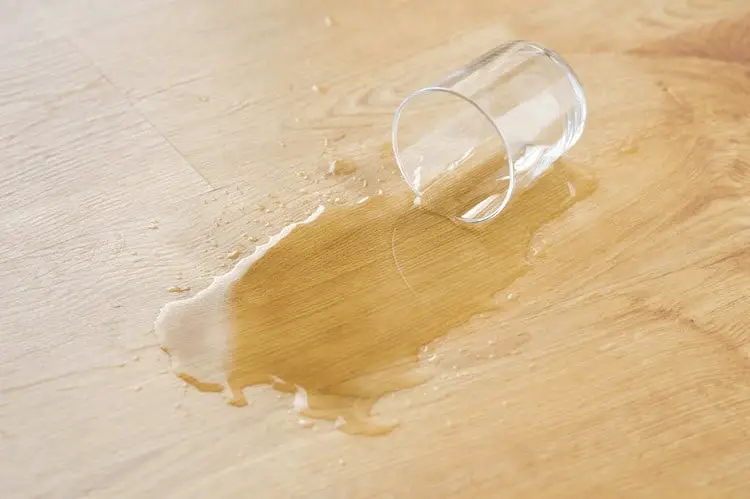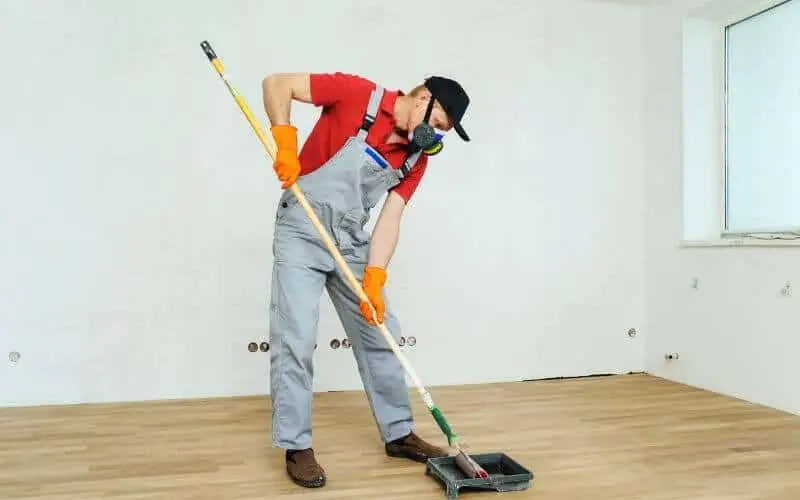Water spill on hardwood floor is potentially dangerous and harmful to the beauty and longevity of the floor. When water spill is left on hardwood floors, it can permanently ruin the hardwood; the wood will absorb the water through its pores and then discoloration and warping occurs on the wood.
Therefore, if there is a water spill on your hardwood floor, it is expedient that you get rid of the water and dry the floor immediately; the longer the wood is in contact with water, your floor damages even worse.
If you get rid of water from your hardwood floor swiftly and properly dry it, you will still be able to salvage most of the wood if not all.
Tackling water spills on hardwood floors involves finding the source of the spill or leakage and fixing it. Suck up any standing water using a vacuum and clean the surface of the floor to prevent mold growth.
In some cases, you will have to sand and refinish the hardwood floor thereafter, and then your hardwood floor will look new.
How to Tackle Water Spill On Hardwood Floors
Table of Contents
- 1 How to Tackle Water Spill On Hardwood Floors
- 1.1 Find and Stop the Source of the Water Spill
- 1.2 Remove Wet Items from the Area
- 1.3 Suck Up All the Standing Water
- 1.4 Clean the Surface of the Floor With a Disinfectant
- 1.5 Make Use of a Dehumidifier
- 1.6 Supplement the Dehumidifier with Large Fans
- 1.7 Use a Moisture Meter
- 1.8 Sand and Refinish your Hardwood Floors
- 2 How to Minimize Water Spill on Hardwood Floor
- 3 Why Should I Tackle Water Spill on my Hardwood Floor?
- 4 Conclusion
Find and Stop the Source of the Water Spill
If moisture continues penetrating the hardwood, you are back to square one. Therefore, you have to find the source of the leakage or spill and fix it before the issue gets worse.
Remove Wet Items from the Area
Depending on the level of water spillage, move furniture and any other wet item outside in the sun or at least to another room.
If the items are wet and you have to keep them inside for any reason, move them to a waterproof floor and to be extra cautious, place plastic between the floor and the furniture.
Suck Up All the Standing Water
You have to use a wet vacuum to suck up as much water as possible from the floor. Continue sucking up the water with the vacuum for some time even after you’ve removed all the water you can see; there is still some water in the invisible pores of the wood.
Clean the Surface of the Floor With a Disinfectant
This is done so that you can preserve your hardwood floor and also prevent mold growth. Use a non-lathery disinfectant to clean the surface of your hardwood floor. When you are through, use the wet vacuum once again to remove any remaining water.
Read: Using Windex on hardwood floor
Make Use of a Dehumidifier
Position a dehumidifier in the middle of your room. If you can place more than one, better. Make sure you dispose of the water every few hours and also ensure that the filter is clean.
See that the dehumidifier runs for a minimum of 24 hours. Depending on the extent of the water spill, you can run the dehumidifier for 2-3 days.
Minimize foot traffic on the area while the hardwood floor is drying, to allow the floor to dry evenly and faster.
Supplement the Dehumidifier with Large Fans
Speed up the drying process of the hardwood floor using fans. Put the fan/s on full blast and point them towards the floor. It is better if you have a fan that oscillates.
Open windows and doors to ensure cross ventilation and evaporation of excess moisture. If it is raining or highly humid outside, keep the windows closed and leave the doors to other rooms open, while still using a dehumidifier.
Make sure your fans are clean and free from dust before you use them. Also, make sure all wires and plugs are out of the reach of water.
Read: Should humidifier be on the floor?
Use a Moisture Meter
Depending on the extent of water spillage, it can take a long time for your hardwood floor to completely dry, as the sub-floor might be retaining moisture too.
You must wait for the floor to dry before you sand it, if not, you will have all sorts of issues as the wood might continue contracting and the floor won’t be restored properly.
If this happens, you will need to sand and refinish the floor for a second time, incurring more costs and wearing down your wood. So, make sure that you test the moisture of your hardwood floor before sanding it.
Test the floor in different spots; some areas have more moisture than other areas. The moisture content should be between 6-9% before the hardwood is sanded.
Sand and Refinish your Hardwood Floors
Depending on the extent of water spillage, water usually wears down the polyurethane finish on hardwood floors. Even if there is still some polyurethane finish left on your hardwood floor, it is likely much thinner and won’t last too long, so you should refinish the floor.
If there is minor cupping on the floor, sanding will take care of it. Invite a professional for advice, if you are stuck or unsure of anything.
Read: How to refinish terrazzo floors
How to Minimize Water Spill on Hardwood Floor
- Check and fix leaky or frozen pipes
- Prevent water heater from busting
- Avoid toilet overflowing
- Take precautions to prevent your dishwasher or washing machine from breaking
- Fix roof leaks
- Take appropriate steps to prevent fire accidents (calling for quenching with water)
Why Should I Tackle Water Spill on my Hardwood Floor?
When your hardwood floor gets wet, the wood absorbs the water and begins to expand, and sooner or later warp, this often leads to wood floor buckling. The sides of the hardwood flooring then swell and rise higher than the center of the floorboards, thereby creating an uneven surface.
If the water is on top of the hardwood finish, it will penetrate through the cracks between the planks and will be absorbed by the plywood sub-floor beneath the hardwood.
In the case of engineered hardwood, water can pass through the planks and loosen the glue underneath, and then the floor will begin popping up as it expands.
Removing the water immediately and drying the floor decreases the chances of damage and also prevents the likelihood of future molds growths which are toxic to both human beings and pets’ health.
Uncleaned water spills may also result in dark stains on hardwood floors (very difficult to remove). Also, removing water spills on hardwood floor reduces the dangers associated with slippery wood floors.
Conclusion
Water spill on hardwood floor can damage the floor if not attended to promptly. The longer the water stays on the floor, the worse the floor will become and consequently, the more difficult it becomes to restore the floor.
This even leads to white spots on hardwood floor. Therefore, always perform regular cleaning of the floor and protect the floor from water spills, to keep the floor beautiful and durable.

